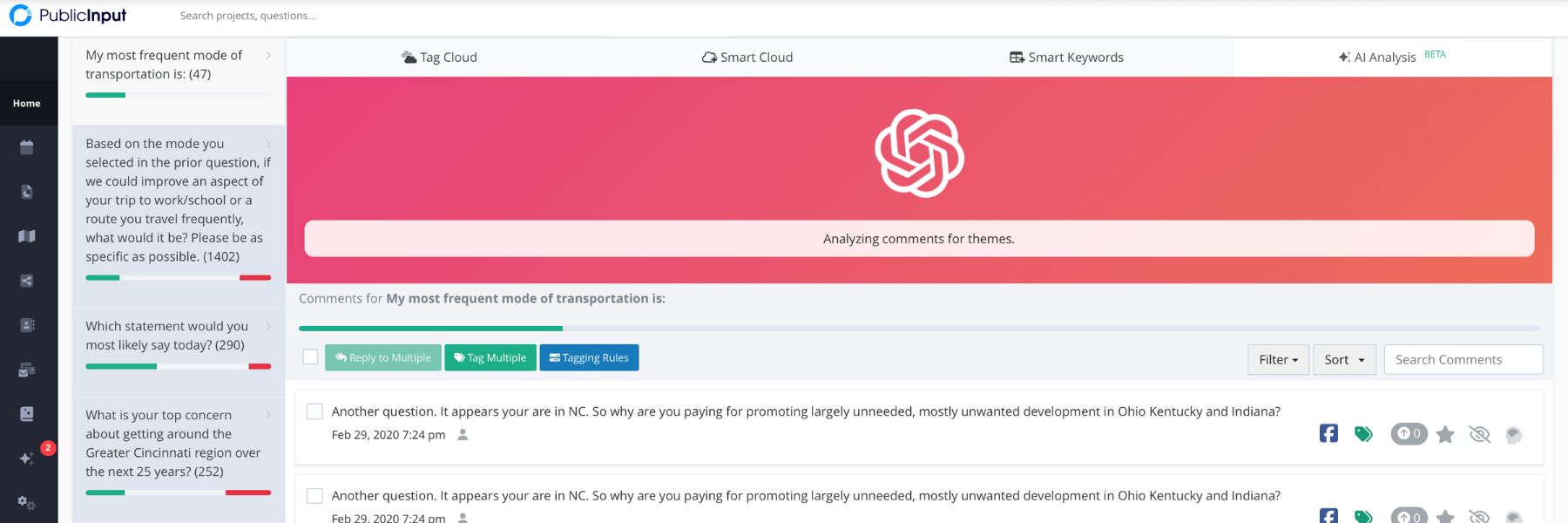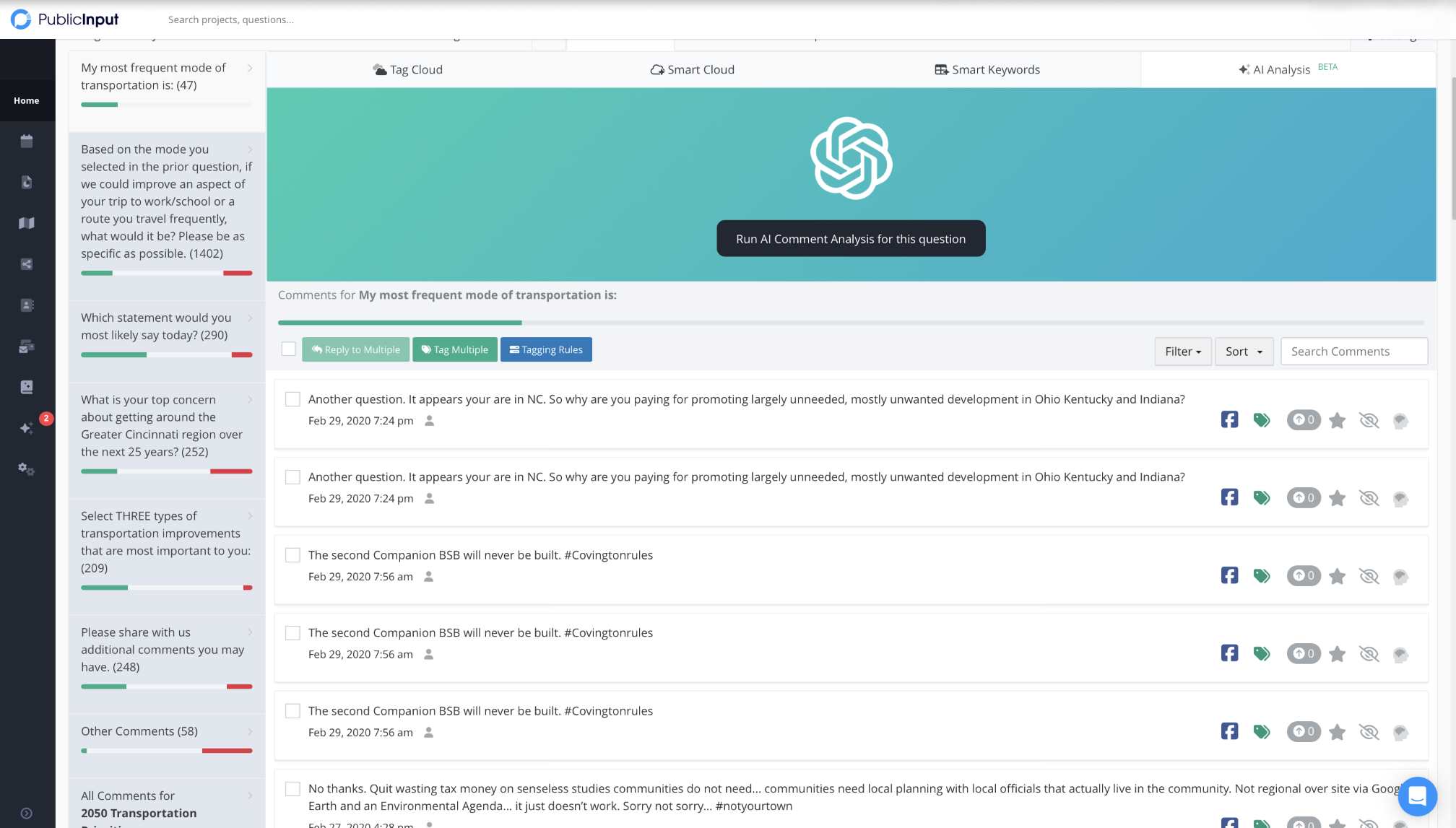
PublicInput’s GPT Comment Analysis Tool is designed to help public engagement professionals efficiently analyze and understand community feedback. Leveraging the power of OpenAI’s GPT (Generative Pre-trained Transformer) technology, this tool automates the process of categorizing and summarizing large volumes of public comments.
Watch the product demo session for a walkthrough of the tool.
FUNCTIONALITY
The GPT Comment Analysis Tool efficiently analyzes public comments, enabling you to sort and review large volumes of feedback in minutes. You can group and categorize comments by tags and themes that you define, ensuring the analysis aligns with your project’s needs. With control over trends and tagging, the tool adapts to your requirements, providing customized insights into public perception and sentiment.
Here are the key features:
-
- Automatically identify key themes. The AI quickly identifies common trends in your comments, making it easier to understand public preferences and sentiment.
- Tag comments by topical area. The Comment Tagging feature automatically categorizes comments by topical areas, allowing users to easily navigate and gauge support using the AI analysis tab and “upvoting” feature. AI-generated tags are assigned based on trends, such as tagging “extend streetcar uptown” as “rail transit.”
- Supports quality review and modification of output. Review and adjust AI-applied tags or create new ones to ensure accuracy. Maintaining high-quality data allows for precise and actionable community engagement insights.
- Supports sentiment analysis. Sentiment bars provide a quick overview of public sentiment, indicating whether comments are mostly positive or negative.
- Integrate comments from multiple sources. Automatically incorporate feedback from various platforms, such as emails, social media, and smart transcripts from meetings. This improves your engagement data and provides a comprehensive view of community input. As long as those comments have been imported to your project, you can run GPT analysis on them!
- Incorporate findings into reporting. Visualize tags in reports, segment data, and follow up with respondents based on their tagged comments. This enables you to generate reports or directly respond to tagged comments.
- Keep your data/PII safe. This tool is designed to protect user privacy by only analyzing publicly available information, so you don’t have to worry about uploading confidential data. It removes personally identifiable metadata from comments before processing and uses the latest encryption practices to keep your information secure and confidential.

WHAT THE TOOL IS DESIGNED TO DO
Analyze open-ended questions.
Leverage the tool’s capability to handle open-ended questions, generating key trends and insights from extensive and varied public input.
Example: When conducting a community survey about park improvements, the tool can analyze responses like “I want more benches” or “Add a playground,” quickly identifying the most requested features and helping planners prioritize changes based on community needs.
Identify common trends.
Easily identify common trends across comments, making it simpler to understand public sentiment.
Example: After a public forum on transportation issues, the tool can sift through comments to reveal a trend such as “increase bus frequency,” allowing decision-makers to see that improving public transit is a widespread concern among residents.
Report on trends visually with word clouds.
Improve your reports with visual data by using the tool’s tags to highlight key insights.
Example: By generating a word cloud from comments about community events, you can visually represent popular topics, such as “family activities” or “live music,” making it easier to identify which types of events resonate most with the community.
Connect with large groups of your audience.
Group similar comments together to streamline responses and address issues more effectively.
Example: If multiple residents express concerns about “traffic congestion” in a specific neighborhood, the tool can group these comments, allowing city officials to craft a focused response that acknowledges these concerns and outlines potential solutions, such as traffic studies or road improvements.

WHAT THE TOOL ISN’T DESIGNED TO DO
Specific user recommendations or feedback.
While the current process is effective at generating high-level themes, it may not provide detailed resident comments. To gain deeper insights, we recommend reviewing the individual comments within each theme to extract more specific information.
Specific location details.
While the AI identifies trends such as “increase green space,” it does not provide specific details about locations like “Central Park”, which means users will need to conduct further analysis to pinpoint where those trends apply.
TIPS FOR BEST RESULTS
-
-
MAKE TAGS SPECIFIC: Use specific tags like “Supports bike lanes” for clarity.
-
MULTI-TASK: The GPT Comment Analysis tool allows for multiple scans running at the same time.
-
ADD CUSTOM TAGS: Ensure all nuances are captured by adding your own tags.
-
RUN ANALYSIS THROUGHOUT YOUR INITIATIVE: Analyze comments mid-initiative to assess and adjust your outreach strategies in real time. This way, you can see if your efforts are effective and make necessary tweaks for better results. To manage your comments, run the analysis and click “Archive” when you’re ready to run it again.
-
PRACTICAL USE CASES
Use Case #1: Real-Time Feedback Management
-
- Scenario: You want to monitor the progress of a city planning project, identify early themes, and pinpoint areas for improvement mid-engagement.
- How the Tool Helps: The GPT Comment Analysis Tool identifies trends such as “Support for Green Spaces” or “Concerns About Traffic” quickly. This allows you to:
- Present Clear Insights: Easily share key trends with stakeholders.
- Address Recurring Issues: Identify and respond to common concerns efficiently.
- Adjust Your Plan: Run the analysis periodically (e.g., once a week) to see how the feedback evolves. This helps you tweak your outreach strategy in real-time, ensuring your engagement plan remains effective throughout the project.
Use Case #2: Categorizing Trends and Public Sentiment
-
- Scenario: You want to gather and understand feedback on proposed changes to a city’s transit system to ensure the community’s voice is heard and to address their concerns effectively.
- How the Tool Helps:
- Categorize trends: The tool identifies and categorizes comments into trends such as “Requests for Additional Bus Routes” and “Concerns About Fare Increases,” helping you prioritize key issues.
- Analyze Sentiment: It also categorizes sentiment, providing a clear picture of public opinion—whether positive, negative, or neutral.
- Pull Quotes: Extract impactful quotes to highlight specific concerns or support, making it easier to communicate findings and address community feedback effectively.
Use Case #3: Create Insightful Reports
-
- Scenario: You want to analyze public input on a new environmental policy to understand community perspectives and inform future decisions effectively.
- How the Tool Helps:
- Pull Key trends: The tool identifies and categorizes key trends such as “Support for Renewable Energy” and “Opposition to New Regulations,” providing a clear overview of public opinion.
- Use the Tag Cloud: Leverage the word cloud feature to visualize and pull strong trends, creating a compelling and easy-to-understand report.
- Share with Stakeholders: Present the nuanced insights and trends to stakeholders, informing the decision-making process and ensuring transparency in the policy evaluation process.
For more on how to use this feature, please see GPT Comment Analysis: Using AI to Save Hours on Comment Coding. If you’re interested in having a demo of the GPT Comment Analysis Tool, reach out to your customer success manager or request a demo below.



